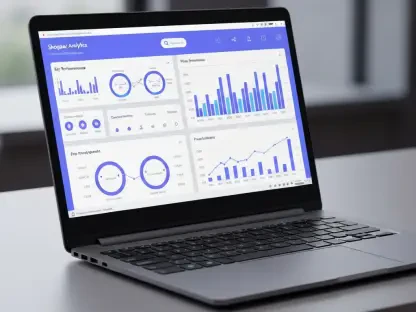The recent mass IT outage affecting Microsoft systems has caused significant disruptions across various sectors globally, particularly retail and transportation. The incident serves as a stark reminder of the heavy reliance on digital infrastructure and the vulnerabilities inherent in this dependence. From retail checkouts to airport operations, the widespread impact underscores the need for diversified IT strategies and robust contingency planning.
Immediate Impact on Retail and Transportation
Cascading Effects on Retail Operations
One of the most visible impacts of the outage was the disruption of point-of-sale (POS) systems across numerous retail establishments. Retailers ranging from small cafés to large department stores experienced the infamous blue loading screen, leading to significant inconveniences. High-profile cases included Starbucks only being able to accept cash and the UK bakery chain Gail’s being unable to process payments entirely. The inability to use POS systems not only caused delays but also resulted in lost sales and frustrated customers.
The interruption of retail operations extended beyond lost sales; it complicated inventory management, disrupted customer loyalty programs, and impeded financial reporting. Businesses had to quickly find workarounds such as manual processing of transactions, which is not only time-consuming but also prone to errors. The operational hiccups also put frontline employees under tremendous stress as they dealt with agitated customers and attempted to navigate an increasingly chaotic environment. Collectively, these disruptions underline the importance of having backup systems to maintain business continuity.
Airport and Transportation Disruptions
The aviation industry was not spared, with several airports reporting issues with their systems. Flight check-ins and baggage handling processes experienced delays due to the IT failure, compounding the stress for travelers during peak travel times. This highlighted how deeply integrated IT systems are within critical infrastructure, making them susceptible to widespread disruptions from seemingly isolated issues.
Airports had to resort to manual processes, which slowed operations significantly, leading to long queues and passenger dissatisfaction. The impact extended beyond the terminals; airline schedules were thrown off balance, causing a ripple effect of delayed flights and missed connections. Ground transportation services such as car rentals and ride-hailing companies also faced technical issues, exacerbating the logistical chaos. The events highlight the critical need for resilient IT systems and contingency plans to avert such widespread disruptions in essential services.
Root Causes and Underlying Vulnerabilities
The Role of Third-Party Software
The underlying cause of the disruption was traced back to an update from a third-party software platform, specifically from IT security firm CrowdStrike. This update affected Microsoft’s technology, showing how interconnected and dependent modern IT systems have become. The issue underscores the vulnerabilities that can arise from dependencies on third-party updates and the need for rigorous testing and validation processes.
Third-party software integrations are a double-edged sword in the IT ecosystem. While they offer specialized functionalities and enhance overall system capabilities, they also introduce additional points of failure. In this case, the CrowdStrike update triggered a chain reaction of issues within Microsoft’s systems, demonstrating how a seemingly isolated update can have cascading effects. The incident serves as a cautionary tale for businesses to scrutinize third-party software dependencies and rigorously test updates in a controlled environment before wide-scale deployment to avoid similar pitfalls.
Interconnected IT Systems
The outage drew attention to the broader implications of interconnected IT systems. When one component fails or is disrupted, the effects can cascade throughout the entire infrastructure, leading to widespread operational challenges. This phenomenon was evident as businesses dependent on Microsoft’s infrastructure faced immediate setbacks, revealing the fragility of digital ecosystems that lack adequate redundancy and backup plans.
Complex IT ecosystems are the backbone of modern business operations, but their interdependencies make them fragile. A disruption in one system can trigger a domino effect, compromising multiple layers of operational processes. This is especially critical for businesses with a global footprint where diverse operations are tightly integrated. The incident has prompted companies to reevaluate their IT architectures to identify and mitigate points of failure, emphasizing the importance of creating robust, multi-layered backup plans and diversifying technological dependencies to enhance operational resilience.
Broader Implications for Businesses
Dependence on Single IT Providers
A recurring theme in the aftermath of the outage was the heavy reliance on a single IT provider for critical business operations. This dependence streamlines processes under normal conditions but poses a massive risk during failures. The Microsoft outage has reinforced the importance of diversifying IT suppliers to mitigate such risks, promoting a more resilient and adaptable approach to business continuity planning.
Businesses tend to gravitate towards single providers for the perceived benefits of integration and cost-effectiveness. However, the risks associated with this approach became glaringly evident during the Microsoft outage. The disruption serves as a wake-up call for companies to spread their technological risks by adopting a multi-vendor strategy. This includes not only diversifying IT infrastructure providers but also ensuring that secondary systems are in place to take over in case of a primary system failure. An interdisciplinary approach involving IT, operations, and risk management teams can help create a more resilient business environment.
Need for Robust Contingency Plans
The consensus among industry experts is clear: businesses must incorporate robust contingency plans to handle IT disruptions effectively. This includes not only diversifying suppliers but also ensuring regular backups, establishing failover systems, and maintaining comprehensive incident response strategies. The objective is to minimize downtime and maintain operational integrity even when primary systems fail.
A well-formulated contingency plan goes beyond simple backup systems; it involves orchestrated actions and communications across various organizational levels. Regular drills and scenario planning can prepare teams to respond swiftly and effectively during outages. The Microsoft incident has driven home the need for businesses to invest in modern failover technologies and robust disaster recovery frameworks. Furthermore, cross-training employees on emergency procedures and having predefined communication channels are critical for minimizing operational disruptions and maintaining customer trust during crises.
Technological Trends and Future Directions
Growth of Cloud-Based Solutions
The increasing adoption of cloud-based POS systems and contactless payment methods has been a notable trend in recent years. These technologies offer enhanced convenience and efficiency but are also susceptible to widespread disruptions, as demonstrated by the Microsoft outage. Businesses must weigh the benefits of these advancements against the potential risks and take proactive measures to enhance their IT resilience.
Cloud solutions provide scalability and flexibility but come with their own set of vulnerabilities. Outages such as the recent Microsoft incident expose the risks tied to centralized systems, prompting businesses to consider a hybrid approach that combines cloud solutions with on-premise capabilities. This strategy can offer a balanced mix of flexibility and control, ensuring that critical operations continue uninterrupted even if the cloud services face downtime. Regular audits and incorporating advanced monitoring tools can help identify risks early, enabling preemptive measures to mitigate potential disruptions.
Cybersecurity as a Priority
In the wake of the outage, there is a heightened awareness of cybersecurity’s role in maintaining business continuity. Ensuring secure and reliable systems is crucial, given the ever-present threats posed by cyberattacks and system vulnerabilities. Investment in cybersecurity infrastructure, continuous monitoring, and regular updates are imperative to safeguard against future disruptions.
Effective cybersecurity measures extend beyond defense mechanisms; they involve cultivating a culture of vigilance and resilience across the organization. Employees should undergo continuous training to recognize and respond to potential threats. Implementing advanced threat detection systems, periodic security audits, and adopting zero-trust architectures are some of the strategies businesses can employ. In light of the Microsoft outage, it’s evident that robust cybersecurity frameworks are not just about preventing breaches but also ensuring quick recovery and sustained operations, making them an indispensable part of modern IT strategy.
Residual Impacts and Long-Term Changes
Lingering Service Issues
Despite Microsoft’s announcement that the underlying issue had been resolved, some services continued to experience residual impacts. This has highlighted the protracted nature of resolving deep-rooted IT failures and the importance of ongoing vigilance and maintenance. Businesses affected by the outage have had to navigate challenges even after the initial resolution, emphasizing the need for durable and robust IT support mechanisms.
Residual issues underscore the complexity of fully resolving significant IT disruptions. Temporary fixes may restore baseline functionality, but underlying vulnerabilities can linger, causing intermittent problems. This ongoing struggle necessitates continuous investment in IT support and maintenance. Regular system audits, comprehensive testing of repaired systems, and proactive monitoring are essential to ensure that any latent issues are promptly identified and addressed. The prolonged recovery period has emphasized that maintaining operational integrity in the face of IT disruptions requires a sustained and diligent approach to system management.
Strategic Shifts in IT Approaches
The recent widespread IT outage affecting Microsoft systems has caused significant disruptions across various sectors on a global scale, particularly hitting retail and transportation industries hard. This incident starkly highlights the profound dependence on digital infrastructure and the inherent vulnerabilities that come with it. From retail checkout systems to airport operations, the extensive impact of the outage underscores the urgent need for diversified IT strategies and robust contingency planning. Retailers faced massive issues, with point-of-sale systems going offline, leading to lost sales and customer dissatisfaction. Meanwhile, airports experienced delays and operational hiccups, impacting countless travelers and cargo shipments. This event underscores how essential it is for organizations to not only invest in prime IT infrastructure but also to develop resilient backup systems. Companies need to diversify their IT resources and prepare comprehensive contingency measures to mitigate such far-reaching disruptions. This outage serves as a crucial lesson in the necessity of proactive planning in the digital age.









